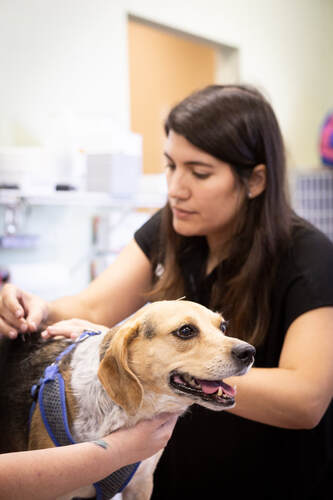Many animals suffer in pain without their owners having much knowledge that their loved one is uncomfortable. Arthritis, old injuries, increased weight and sometimes hidden neurological problems can all contribute to decreased mobility and function. Pain in animals is not always obvious, it can be subtle. Decreased activity, changes in behavior, limping, or even just trouble getting up are a few commonly overlooked symptoms.
Acupuncture and Traditional Chinese Medicine

Acupuncture is the stimulation of acupoints that also coincide with high density areas of nerves ending, mast cells, small blood and lymphatic vessels. Scientific research shows that stimulation of these acupoints helps release beta-endorphoins, serotonin, and other neurotransmitters. What this means is that your pet will feel better and have less pain. Our main goal for patients receiving acupuncture is to decrease pain. When adding acupuncture we can many times reduce or eliminate the need for oral medications. Reducing the chance of side effects and pain can have a tremendous impact on quality of life and overall function for both the pet and their human.
Acupuncture is tolerated very well by most patients. The needles used are very barely larger than the diameter of hair. The needles are placed 1-2mm in the skin and many patients fall asleep during treatment. The number of treatments needed depend on the patients problem and therapeutic response to treatment.
Acupuncture is tolerated very well by most patients. The needles used are very barely larger than the diameter of hair. The needles are placed 1-2mm in the skin and many patients fall asleep during treatment. The number of treatments needed depend on the patients problem and therapeutic response to treatment.

Benefits of Acupuncture:
Common and NOT so Common Symptoms of Pain in Animals
Conditions Treated with Acupuncture
- Pain Relief
- Promotion of tissue healing
- Regulation of gastrointestinal motility
- Anti-inflammatory effects
- Immunoregulation
- Hormone and reproductive regulation
- Antifebrile Effects
Common and NOT so Common Symptoms of Pain in Animals
- Excessive Panting
- Limping or Favoring a Limb
- Lethargy
- Behavioral Change
- Difficulty Getting up
- Decrease in Overall Activity(even if they are old)
- Hiding
- Inappropriate Elimination
- Yelping/ Whining (when an animal is in extreme pain)
Conditions Treated with Acupuncture
- Musculoskeletal Conditions
- Osteoarthritis
- Neurological Disorders
- Lumbosacral Disease
- Intervertebral Disc Disease(IVDD)
- Neuropathies
- Diarrhea
- Constipation
Additional Therapies and Treatment for Pain Management
Pain management is the foremost component of getting your pet back to normal function and/or a better quality of life. Breaking the pain cycle through a multimodal approach is the best course of action. Pharmacological therapy is a well known and effective way to help control pain, but it can also hold some side effects. However, its use does not always have to be forever. We may strongly recommend medications for you pet at first but we will also do our best to provide other therapies and interventions to lessen the amount of drugs used and/or stop them all together.
Pain management is the foremost component of getting your pet back to normal function and/or a better quality of life. Breaking the pain cycle through a multimodal approach is the best course of action. Pharmacological therapy is a well known and effective way to help control pain, but it can also hold some side effects. However, its use does not always have to be forever. We may strongly recommend medications for you pet at first but we will also do our best to provide other therapies and interventions to lessen the amount of drugs used and/or stop them all together.
- Acupunture
- Eletro-acupunture
- Electrical Stimulation
- Food Therapy
- Herbal Medicine
- Land Based Therapeutic Exercise
- LASER therapy
- LASER therapy to acupoints
- Medical Manipulation
- Pharmacological therapy
- Surgery
- Underwater Treadmill

